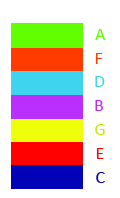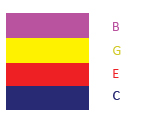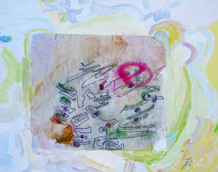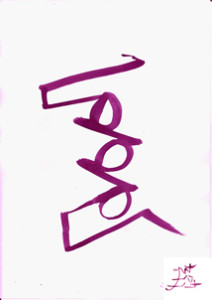A colour musical scheme.
My colour scheme is equivalent to the 12-tone musical scale. This is divided primarily into its namesake of 12 equal parts, any interval can be defined in terms of appropriate colour terms. This can be achieved by the loose use of a colour bias wheel,( as described by Michael Wilcox in his book, Blue And Yellow Don’t Make Green, this is the first step.)– annotation
The second step is the most important because it’s where the final outcome is arrived at. This important step is called INTERPRETATION, the creative part. It is our own interpretation that makes us stand apart. As we are all individuals, we are meant to think independently. then a style of interpretation should be for each one of us. Then, one may ask, why it isn’t so?
Art is the result of some thinking, the interesting part is what type of thinking or thinking(s)? The why and how, and how it is presented is just as important. Ideas change, and values change, as history can testify. We are in a century of mobile ideas, and so there will be more changes at a more accelerated pace.
Parallel thinking is how I visualize the use of colour in my ecosystem.
One way of describing my methodology is akin to traffic thinking, travelling in parallel lines. It’s orderly and sometimes not so orderly fashion. There are rules, but we push beyond them.
When I came to create my musical notation system, the first thing that I developed was a musical colour equivalent scheme which is based on the colour wheel. It is meant to function in general as the traditional music notation system.
Tradition notation served us well, but is it the only system? Could it be that out there, there is something better, and more appropriate to today’s needs? A type of notation that can be hand notated with more scope of holding data per character and versatile? Yet, when developed has the potential to be electronically more efficient and encompassing?
First, the colour chord of C major was developed and the rest of the colour chords simply followed suit. The colour scale became in this instance, a by-product of the colour chord of C major. The foundation of this colour chord scheme is the colour chord and not the colour scale.
Some of the reasons for creating this are.
As a guide to visualize musical notes, and to give the notes a sense of the basic elements of dynamic visual design.
To help quickly with familiarizing, remembering, and reinforcing the new musical symbols.
To, formulate a musical pictorial composition idea visually.
The colour scheme is not meant to be a scientific model, as there are other more efficient means to do so. It is mean it to be, a general open idea, a plan to a means.
Colour chords:
Piano white keys:-
Blue (C – Do), Red (E – Mi), Yellow (G – So), Fuschia (B – Ti), Cerulean (D – Re), Orange (F – Fa), and Light green (A – La).
Colour chord of C – Do.
Colour chord of E – Mi.
Colour chord of G – So.
Colour chord of B – Ti.
Colour chord D – Re.
Colour chord of F – Fa.
Colour chord of A – La.
Colour chord of C7.
.
Piano white keys:-
C:- Ultramarine
D:- Cerulean Blue
E: Cadmium Red
F:- Cadmium Orange
G:- Cadmium Yellow
A:- Light Green
B:- Fuchsia
Piano black keys:-
C#/Db:- Purple
D#/Eb:- Light Red Oxide
F#/Gb:- Yellow Oxide
G#/Ab: HEX: #3E9916 or G#/Ab Green or similar.
A#/Bb: Phthalo Green
Please do not forget they are approximations as there are variations in manufacture between different batches of similar paints.
To be continued
Sam’s Music Notation System.
At some point, I will give a brief description of the notation which can also be found in my paintings. At the moment I’m committed to other numerous art projects.
Inspired by Debussy: Reflects Dam 1905 
Chord of_ F major.
Copyright 2017.











